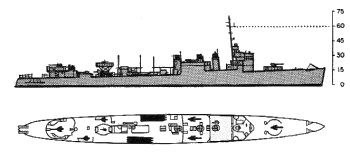![]() The Pacific War Online Encyclopedia
The Pacific War Online Encyclopedia
|
| Table of Contents |
|
|
 ONI 222 |
| Tonnage | 1090 tons standard displacement |
| Dimensions | 314'3" by 31'8" by 9'10" 95.78m by 9.65m by 3.00m |
| Maximum speed | 35 knots |
| Complement | 150 |
| Armament | 4x1 4"/50 guns 1 3"/23 AA gun 4x3 21" torpedo tubes 2 depth charge racks (15 depth charges) 1 depth charge thrower |
| Machinery |
2-shaft Parsons turbines
(24,200 shp) 4 White-Foster boilers |
| Range | 2500 nautical miles (4600 km) at 20 knots |
| Fuel |
295 tons fuel oil |
| Modifications |
A number of units were converted before the war to light minelayers by replacing the torpedo banks with storage for 80 mines. These eventually replaced their 4" guns with 3"/50 AA guns and 4 20mm Oerlikon AA guns. 1940-1942: A number were converted to
fast
minesweepers armed with 4 3"/50 guns, 1x2 40mm Bofors
AA guns, and 3 to 5 20mm guns. One boiler was
removed. Squared-off false sterns were added to support
minesweeping gear. Later two 60kW turbo-generators were
installed to support magnetic mine sweeping. Some of these
units later removed most of the 3" guns. 1942-1943: A number were converted to fast transports by replacing all torpedo banks with davits for four LCVPs. All fast transports eventually replaced the 4" guns with 6 3"guns, 2x1 40mm guns, and 5 20mm guns and removed their forward boilers, greatly reducing their speed. They could carry a company of Marines. |
The Wickes were the first of two major groups of
“flush-deck” destroyers ordered by the United States during World
War I. Also known as “four-stackers,” they were essentially a mass
production version of the Caldwells. (For
example, Ward commissioned in just 70 days.) However, they
were given more powerful machinery, which was intended to give
them the speed to keep up with the Omaha-class scout cruisers and the
(never-completed) Constellation-class
battle cruisers.
Because of the urgency placed on rapidly expanding the destroyer
force, the Navy deliberately chose a familiar design with
acceptable characteristics rather than a more innovative design
resembling the new British
"V&W" destroyers. As
a result, these ships were already obsolescent when they joined
the fleet in 1918-1920.
The ships had a serious reputation for rolling, and the
"V" form adopted for the stern, while improving range, also made
the ships very unmaneuverable, with a tactical diameter of 860
yards, which was about 40 to 50 percent greater than contemporary
British destroyers. It was also discovered that the endurance
varied greatly among units of the class. Those built at the Cramp
or Bath yards exceeded
requirements, while those built at Mare Island had little more
than half the endurance of the Cramp and Bath ships in spite of
being built to a nominally identical design. A proposal to replace
one boiler with a fuel tank was rejected and the units with the
poor range were the first to be retired.
Although 32 had been scrapped by 1940, so desperate were the Allies for destroyers in 1941 that the remaining ships constituted a significant part of their destroyer flotillas. Some 22 were transferred to the British as part of the destroyers-for-bases agreement that prefigured Lend-Lease.
The fast transport conversions were considered a success
in the South Pacific, and additional units were converted, both
from the Wickes and from
other destroyer and destroyer
escort classes.
| Crosby | San Diego | Converted to fast transport 1943-2-1 |
| Dent |
San Diego | Converted to fast transport 1943-3-7 |
| Converted to target ship 1944-11-9 | ||
| Lawrence | San Diego | |
| Schley | Converted to fast transport
1943-2-16 |
|
| Ward | Pearl Harbor | Converted to fast transport
1943-2-6.
Crippled by kamikazes
1944-12-7 off Ormoc and
scuttled. |
| Stewart | Tarakan | Scuttled 1942-3-2 at Surabaya. Raised and
recommissioned by the Japanese
as PB-102 on
1943-9-20 |
| Talbot | San Diego | Converted to fast transport 1942-10-31 |
| Waters | San Diego | Converted to fast transport 1942-2 |
| Rathburne
|
San Diego | Training ship. Converted to fast transport 1944-6. |
| Gamble
|
Pearl Harbor
|
Crippled by aircraft
1945-2-18 and not repaired |
| Ramsay
|
Pearl Harbor | |
| Montgomery
|
Pearl Harbor | Mined
1944-10-17 and not repaired |
| Breese |
Pearl Harbor |
| Lamberton
|
Task Force 1
|
|
| Boggs |
Task Force 1 | |
| Dorsey |
Task Force 3 |
|
| Elliot |
Task Force 3 | |
| Howard |
Arrived 1943-11 |
|
| Hogan |
Arrived 1943-11-23 |
|
| Palmer |
Arrived
1943-11-23? |
Sunk by aircraft 1945-1-7 at Lingayen Gulf |
| Stansbury |
Arrived 1943-12-4 |
|
| Hamilton |
Arrived 1943-12-8 |
| Gregory | Arrived 1942-2 |
Sunk by gunfire 1942-9-5 off Guadalcanal |
| Colhoun
|
converted 1942-4 (San Diego) | Sunk by aircraft
1942-8-30 off Guadalcanal |
| Little |
converted 1942-4 (San Diego) |
Sunk by gunfire 1942-9-5 off Guadalcanal |
| McKean |
Arrived 1942-5 |
Sunk by aircraft 1943-11-15 in Empress Augusta Bay |
| Stringham
|
Arrived 1943-7-13 |
|
| Kilty |
converted 1943-1-2 (Mare Island)
|
|
| Dickerson |
Arrived 1943-11 |
Wrecked by kamikazes
1945-4-2 off Okinawa
and scuttled |
| Herbert |
Arrived 1944-3 |
|
| Roper |
Arrived 1945-2-5 |
Wrecked by
kamikazes 1945-5-25 off
Okinawa and not repaired |
 |
 |
 |
 |
 |
 |
 |
 |
References
The Pacific War Online Encyclopedia © 2007-2009, 2011-2012, 2015 by Kent G. Budge. Index